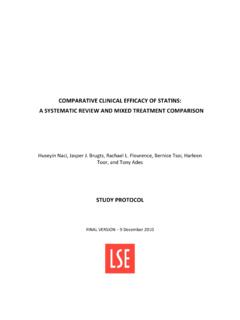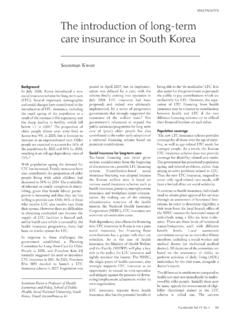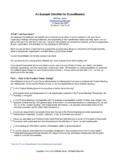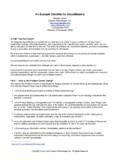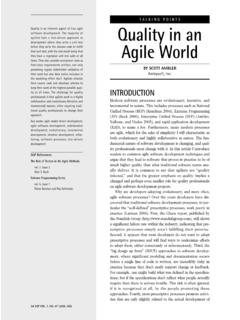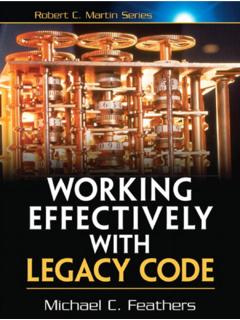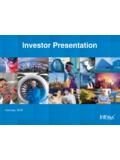Transcription of The Lean Startup - LSE Home
1 The lean StartupEric RiesEntrepreneur and AuthorDr Linda HickmanChair, LSED epartment of Management public lectureSuggested hashtag for Twitter users: #lsestartupEric Ries lean Startup #leanstartupLean Startup PrinciplesEntrepreneurs are everywhereEntrepreneurship is managementValidated LearningBuild Measure - LearnInnovation AccountingLean Startup PrinciplesEntrepreneurs are everywhereWhat is a Startup ? A Startup is a human institution designed to deliver a new product or service under conditions of extreme uncertainty. Nothing to do with size of company, sector of the economy, or industryWhat is a Startup ?
2 Startup =EXPERIMENTSTOPWASTINGPEOPLE STIMEMost Startups FailMost Startups FailMost Startups FailLean Startup PrinciplesEntrepreneurs are everywhereEntrepreneurship is managementWho to Blame Father of scientific management Study work to find the best way Management by exception Standardize work into tasks Compensate workers based on performance In the past, the man was first. In the future, the system will be first. (1911)Frederick Winslow Taylor(1856 1915)Entrepreneurship is management Our goal is to create an institution, not just a product Traditional management practices fail- general management as taught to MBAs Need practices and principles geared to the Startup context of extreme uncertainty Not just for two guys in a garage The PivotI The Pivot What do successful startups have in common?
3 - They started out as digital cash for PDAs, but evolved into online payments for eBay. - They started building BASIC interpreters, but evolved into the world's largest operating systems monopoly. - They were shocked to discover their online games company was actually a photo-sharing site. Pivot: change directions but stay grounded in what we ve learned. Speed WinsIf we can reduce the time between pivotsWe can increase our odds of successBefore we run out of moneyLean Startup PrinciplesEntrepreneurs are everywhereEntrepreneurship is managementValidated LearningAchieving Failure If we re building something nobody wants, what does it matter if we accomplish it:On time?
4 On budget?With high quality?With beautiful design? Achieving Failure= successfully executing a bad plan The lean RevolutionW. Edwards Deming(1900 1993)Taiichi Ohno - (1912 1990) The customer is the most important part of the production line. -DemingSTOPWASTINGPEOPLE STIMELean Startup PrinciplesEntrepreneurs are everywhereEntrepreneurship is managementValidated LearningBuild Measure - LearnMinimize TOTAL time through the loopThere s much FasterSplit TestsCustomer DevelopmentFive WhysCustomer Advisory BoardFalsifiable HypothesesProduct OwnerAccountabilityCustomer ArchetypesCross-functional TeamsSemi-autonomous TeamsSmoke TestsMeasure FasterSplit TestsContinuous DeploymentUsability TestsReal-time Monitoring & AlertingCustomer LiaisonBuild FasterUnit
5 TestsUsability TestsContinuous IntegrationIncremental DeploymentFree & Open-SourceCloud ComputingCluster Immune SystemJust-in-time ScalabilityRefactoringDeveloper SandboxMinimum Viable ProductMeasure FasterFunnel AnalysisCohort AnalysisNet Promoter ScoreSearch Engine MarketingPredictive MonitoringLean Startup PrinciplesEntrepreneurs are everywhereEntrepreneurship is managementValidated LearningBuild Measure - LearnInnovation AccountingThe Toyota Startup WayPeoplePeopleCultureCultureProcessProc essAccountabilityAccountabilityInnovatio n AccountingThe Three Learning Milestones1.
6 Establish the baseline-Build a Minimum Viable Product (MVP)-Measure how customers behave right now2. Tune the engine- Experiment to see if we can improve metrics from the baseline towards the ideal 3. Pivot or persevere- When experiments reach diminishing returns, it s time to pivot. STOPWASTINGPEOPLE STIMEQ uestionsHow do we know when to pivot?Vision or Strategy or Product?What should we measure?How do products grow?Are we creating value?What s in the MVP?Can we go faster? ! Buy the book @ Blog: Get in touch (#leanstartup)- Additional resources- lean Startup Wiki: #1 MythLean means cheap.
7 lean startups try tospend as little money as The lean Startup method is not about cost, it is about speed. Myth #2 MythThe lean Startup is only for Web software The lean Startup applies to all companies that face uncertainty about what customers will want. Myth #3 MythLean Startups are small lean Startups are ambitious and are ableto deploy large amounts of capital. Myth #4 MythLean Startups replace vision with dataor customer lean Startups are driven by a compelling vision, and are rigorous about testing each element of this visionLean Startup PrinciplesEntrepreneurs are everywhereEntrepreneurship is managementValidated LearningBuild Measure - LearnInnovation AccountingMinimum Viable Product Visionary customers can fill in the gaps on missing features.
8 If the product solves a real problem Allows us to achieve a big vision in small increments without going in circles Requires a commitment to iteration MVP is only for BIG VISION products; unnecessary for minimal DeploymentLearn FasterCustomer DevelopmentFive WhysMeasure FasterSplit TestingActionable MetricsNet Promoter ScoreSEM Build FasterContinuous DeploymentSmall BatchesMinimum Viable ProductRefactoringContinuous Deployment PrinciplesHave every problem onceStop the line when anything failsFast response over preventionContinuous Deployment Deploy new software quickly- At IMVU time from check-in to production = 20 minutes Tell a good change from a bad change (quickly)
9 Revert a bad change quickly- And shut down the line Work in small batches- At IMVU, a large batch = 3 days worth of work Break large projects down into small batchesCluster Immune SystemWhat it looks like to ship one piece of code to production: Run tests locally (SimpleTest, Selenium)- Everyone has a complete sandbox Continuous Integration Server (BuildBot)- All tests must pass or shut down the line - Automatic feedback if the team is going too fast Incremental deploy- Monitor cluster and business metrics in real-time- Reject changes that move metrics out-of-bounds Alerting & Predictive monitoring (Nagios)
10 - Monitor all metrics that stakeholders care about- If any metric goes out-of-bounds, wake somebody up- Use historical trends to predict acceptable bounds When customers see a failure- Fix the problem for customers- Improve your defenses at each levelMinimum Viable ProductLearn FasterCustomer DevelopmentFive WhysMeasure FasterSplit TestingActionable MetricsNet Promoter ScoreSEM Build FasterContinuous DeploymentSmall BatchesMinimum Viable ProductRefactoringWhy do we build products? Delight customers Get lots of them signed up Make a lot of money Realize a big vision.







